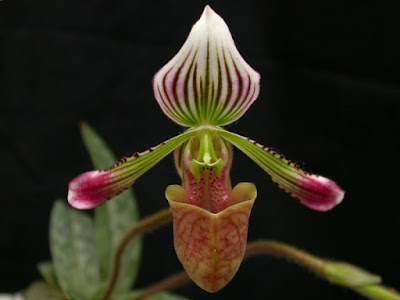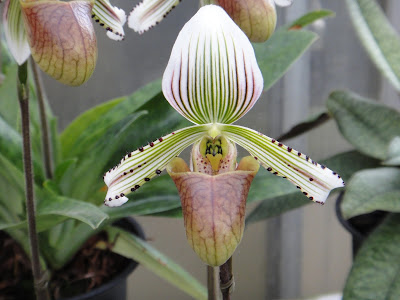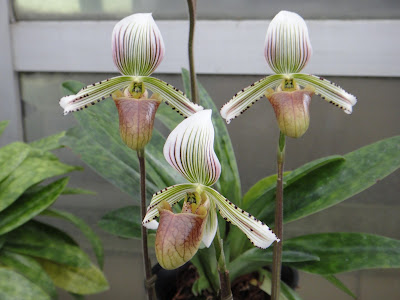Fowlie's Paphiopedilum is native to Philippines. This orchid is discovered on the south-eastern part of Palawan Island near Brooke's Point at an altitude of 600-950 m above sea level. They grow in deciduous litter on limestone rocks. Although they grow in exposed positions, they are rarely exposed to direct sunlight.
Paphiopedilum fowliei orchid, also called as Fowlie's Paphiopedilum, Paphiopedilum fowliei f. christianae, Paphiopedilum fowliei f. sangianum, Paphiopedilum fowliei var. sangianum, Paphiopedilum hennisianum var. fowliei, is a species of the genus Paphiopedilum. This species was named after Jack Fowlie and was described by Lance Birk in 1981.
IDENTIFY PAPHIOPEDILUM FOWLIEI ORCHID
Fowlie's Paphiopedilum is native to Philippines. This orchid is discovered on the south-eastern part of Palawan Island near Brooke's Point at an altitude of 600-950 m above sea level. They grow in deciduous litter on limestone rocks. Although they grow in exposed positions, they are rarely exposed to direct sunlight.
Paphiopedilum fowliei orchid is a small sized, cool to warm growing, semi-terrestrial, which can reach the height 20 cm, with blue gray leaves tesselated with faint patterns. The leaves are 10-14 cm long and 2.5-3.5 cm wide. On the upper surface of the leaves are dark or light blue-green and have patterns arranged in a fuzzy chessboard, while their bottom side is uniformly light green.
It blooms in the spring and summer on an erect, hairy, 10" (25 cm) long, single flowered inflorescence (20-28 cm of length). The flower has a diameter of 3.6-6.6 cm. The upper sepal is white with longitudinal purple and green stripes. It is slightly arched, ovoid, with a sharp tip. Lower sepals are concave, elliptical. Narrow, pubescent petals are covered with veins of green and purple, and on the edges are covered with black warts. The apical part of the petals is colored purple. The petals are curved in the form of the letter S. A large sacciform lip is reddish-green with purple venation.
GROW AND CARE PAPHIOPEDILUM FOWLIEI ORCHID
Cultural information should only be used as a guide, and should be to be adapted to suit you. Your physical location; where you grow your plants, how much time you have to devote to their care, and many other factors, will need to be taken into account. Only then can you decide on the cultural methods that best suit you and your plants.
Light:
Paphiopedilum fowliei orchid needs light level of 20000-30000 lux. The light should be slightly diffused or filtered. The plant should not be exposed to direct sunlight. A constant strong ventilation is necessary.
Temperature:
Throughout the year, the average daily temperature is 26-28 ° C, the average night time 18-20 ° C, which gives a daily temperature drop of 7-9 ° C. The lowest temperatures are observed in winter, and the highest in spring.
Humidity:
This plant need humidity level of 85-90% for most of the year, and decreasing by 2-3 months in late winter and early spring to 80%.
Substrate and growing media:
Fowlie's Paphiopedilum is grown in pots filled with any loose and well-draining substrate that would retain moisture but not wet. Due to the high demand for this species in water, a little more moss of sphagnum should be added to the substrate. This is especially necessary in a room with low humidity. Despite the fact that this orchid grows on limestone rocks, it is not recommended to add limestone pieces to the substrate, since in the cold water they partially dissolve, which leads to an excess of calcium in the substrate.
Watering:
The plant almost needs to be watered abundantly the whole year. This orchid quickly fades when there is a lack of water. Care should be taken that the substrate is not soaked or damp. In winter and spring, watering should be slightly reduced.
Fertilizer:
For most of the year, the plant should be fed alternately with fertilizer with a high nitrogen content, then fertilizer with high phosphorus content. Plants should be fertilized every week or every two weeks with the amount of 1/10-1/4 of the recommended dose of fertilizer for orchids. The accumulation of mineral salts in the pot should be prevented.
Rest period and repotting:
In winter, watering of cultivated plants should be limited, but must not be allowed to stay dry for a long time. Fertilization should be reduced until more intense watering starts in the spring. It is recommended to limit the amount of water and reducing the temperature for the induction of flower buds for one winter month.
With frequent watering, a substrate containing a large amount of moss rapidly decomposes, so the plant needs an annual repot. Repot the orchid in late spring or early summer, immediately after flowering. After the repot, the plant is kept in a cool and shaded place until it recovers.















COMMENTS